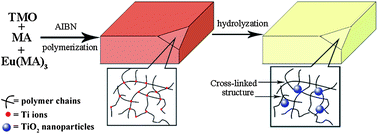Formation of nanoparticles in solid-state matrices: a strategy for bulk transparent TiO2–polymer nanocomposites
Abstract
The incorporation of

* Corresponding authors
a
State Key Lab of Supramolecular Structure and Materials, College of Chemistry, Jilin University, Changchun 130012, People's Republic of China
E-mail:
byangchem@jlu.edu.cn
Fax: +86 431 85193423
Tel: +86 431 85168478
b The Academy of Fundamental and Interdisciplinary Science, Harbin Institute of Technology, Harbin 150001, People's Republic of China
The incorporation of

 Please wait while we load your content...
Something went wrong. Try again?
Please wait while we load your content...
Something went wrong. Try again?
F. Cui, S. Liang, J. Zhang, Y. Han, C. Lü, T. Cui and B. Yang, Polym. Chem., 2012, 3, 3296 DOI: 10.1039/C2PY20330H
To request permission to reproduce material from this article, please go to the Copyright Clearance Center request page.
If you are an author contributing to an RSC publication, you do not need to request permission provided correct acknowledgement is given.
If you are the author of this article, you do not need to request permission to reproduce figures and diagrams provided correct acknowledgement is given. If you want to reproduce the whole article in a third-party publication (excluding your thesis/dissertation for which permission is not required) please go to the Copyright Clearance Center request page.
Read more about how to correctly acknowledge RSC content.
 Fetching data from CrossRef.
Fetching data from CrossRef.
This may take some time to load.
Loading related content
